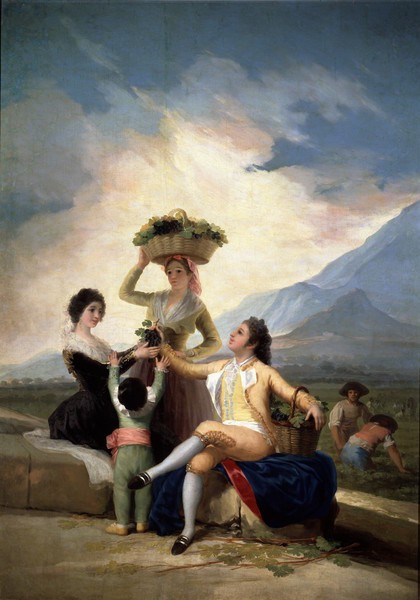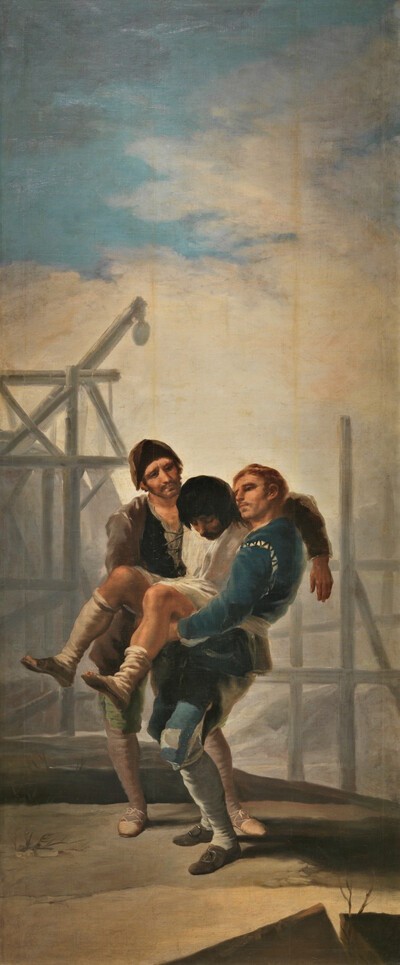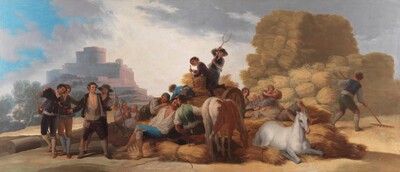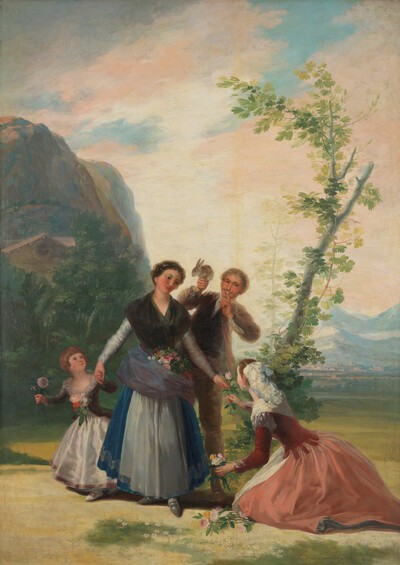- Cronología
- 1786 - 1787
- Ubicación
- The Prado National Museum. Madrid, Madrid, Spain
- Dimensiones
- 267.5 x 190.5 cm
- Técnica y soporte
- Oil on canvas
- Reconocimiento de la autoría de Goya
- Documented work
- Titular
- El Prado National Museum
- Ficha: realización/revisión
- 08 Dec 2009 / 14 Jun 2023
- Inventario
- (P00795)
- Otros títulos:
-
Autumn (El otoño)
See The Flower Girls.
The tapestry of The Grape Harvest would have hung on the south wall of the room, flanking a door with its pair, The Flower Girls, or Spring.
The scene shows some figures in the foreground who dominate the space and the anecdotal subject matter of the grape harvest: an elegant majo who is offering a bunch of grapes to a girl, a young boy with his back to the viewer, reaching up to grab them, and a peasant girl with a basket balanced on her head. Behind them, in the middle distance, appear the figures of more peasants working, and in the background we see a mountainous landscape, which could be the mountains around Madrid.
Bozal says of this cartoon's composition that it is "an authentic review of Goya's painting to date", referring to his genre paintings. The work keeps the pyramid arrangement that the artist began to use in cartoons such as The Drinker and The Parasol. In the case of The Grape Harvest, however, this, the neoclassical arrangement par excellence, breaks away from neoclassicism in the way that Goya combines it with a strongly contrasting distribution of the different planes.
In the centre of the composition we find the grapes, and, just as occurred with the flower in the cartoon of The Flower Girls, the grape here symbolizes this cartoon's season: autumn. Tomlinson offers a further interpretation of this fruit's appearance in the work. At times, the grape has been seen as a representation of the autumn of man, of maturity, and as such, the writer also sees in this painting the three ages of man. Grapes are also thought to symbolize fertility.
Ezquerra del Bayo supposed that the Duke and Duchess of Alba invited Goya and his wife and son to spend some days in their house at Piedrahita, and as such he identifies the aristocrats in the painting as the duke and duchess, the peasant girl as Josefa Bayeu and the boy as the artist's own child. Sambricio proved that this was not possible by citing a letter that Goya wrote to Martín Zapater around those dates, in which he speaks of being in Madrid. What's more, his name appears on several occasions as one of those present at the sessions of the Royal Academy of Fine Arts of San Fernando.
-
El arte europeo en la corte de España durante el siglo XVIIIGalerie des Beaux-ArtsBurdeos1979Exhibitied also at Grand Palais, París y Museo Nacional del Prado, Madridcat. 19 (15)
-
Goya. 250 AniversarioMuseo Nacional del PradoMadrid1996consultant editor Juan J. Luna. From March 29th to June 2nd 1996cat. 37
-
Goya e ItaliaMuseo de ZaragozaZaragoza2008organized by the Fundación Goya en Aragóna, consultant editor Joan Sureda Pons. From June 1st to September 15th 2008cat. 230
-
Goya en Madrid. Cartones para tapices 1775-1794Museo Nacional del PradoMadrid2014p. 267
-
Zaragoza2017cat. 65
-
La Duquesa de Alba y Goya. Estudio biográfico y artísticoMadridBlass1928p. 159
-
L'œuvre peint de Goya. 4 volsParís1928-1950vol. I, p. 92, cat. 33
-
Tapices de GoyaMadridPatrimonio Nacional1946pp. 141, 143, 145, 251, cat. 42 y láms.
-
Goya, Saturno y melancolía. Consideraciones sobre el arte de GoyaStockholmAlquimis & Wiksell1962pp. 55-62 y p. 59 (il.)
-
Vie et ouvre de Francisco de GoyaParísOffice du livre1970p. 97, cat. 264
-
BarcelonaPolígrafa1970vol. I, pp. 268, 270, cat. 219
-
L’opera pittorica completa di GoyaMilanRizzoli1974p. 101, cat. 199
-
Francisco de Goya y la Corte de MadridReales Sitios1980p. 159
-
Francisco de Goya, 4 vols.ZaragozaCaja de Ahorros de Zaragoza, Aragón y Rioja1980-1982vol. II, p. 42
-
Imagen de GoyaMadridLumen1983pp. 72-73
-
Francisco de Goya, cartones y tapicescol. col. "Espasa Arte"Espasa Calpe1987pp. 138, 147, 181, 288, cat. 46C y pp. 1
-
Francisco de Goya. Los cartones para tapices y los comienzos de su carrera en la corte de Madridcol. col. "Ensayos de Arte Cátedra"MadridCátedra1987pp. 211-214 y p. 208 (il.)
-
Goya. 250 AniversarioMadridMuseo del Prado1996p. 317, cat. 37 y pp. 116, 117 (ils.)
-
Salas del Palacio Real de El Pardo para las que se tejieron tapices sobre cartones de Francisco de Goya: identificación de las habitaciones y ajuste de las obras de Goya en los alzados de las paredesin HERRERO CARRETERO, Concha (curator, Tapices y cartones de Goya (catalogue of the exhibition organizated at the Palacio Real de Madrid, from may to june 1996)MadridPatrimonio Nacional, Goya 96, Lunwerg1996p. 164 (il.)
-
Goya en Madrid. Cartones para tapices 1775-1794MadridMuseo Nacional del Prado2014p. 267









